Bead Balancing for Tires – What It Is and Do They Really Work
Tim Esterdahl | Mar 19, 2014 | Comments 13
A few weeks ago, I ran a featured truck story that used bead balancing to keep the tires balanced. I had never heard about bead balancing and by our reader’s responses, neither did they. Here is what they are, how they work and our take on them.
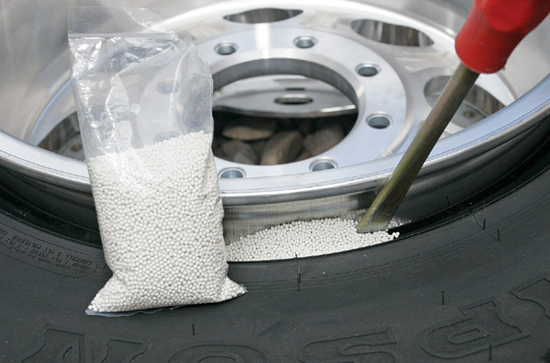
Balancing beads like these Dyna beads are used to balance out the wheel.
The featured truck, Project XU, uses SS M-16 40×14.5R 24 tires from Interco. These monstrous wheels are for a 24×10 rim and weigh an incredible 93 lbs. For reference, the majority of Tundra owners have either 255/70 R18 or 275/65 R18 tires that weigh around 40 lbs. The increased weight and size makes tire balancing a bit more a chore.
With the prospects of a difficult time getting the tires balanced properly, Project XU owner Eric Johnson decided to try to something different. He bought 18 oz of balancing beads. This, in his words, self-balanced the tires as he drove home and he didn’t need to mess around getting them balanced (normally a big deal with large and heavy tires).
What Are Balance Beads?
This got us wondering, what are balance beads and if they work so well why doesn’t everyone use them? Our initial research lead us to Innovative Balancing. They offer “dyna beads” that propose to do tire balancing without the machine. According to the website:
Wheel weights have been around for many years, but are no longer the only solution for trucks, commercial vehicles, trailers, aircraft and motorcycles. We want you to get the highest possible tire mileage by using our products.
The way we do this is by offering a Dynamic Balancing Solution, a high-density ceramic bead that, when easily installed, continuously balances your tires as you drive. The amount of material will distribute itself in weight and position dependent on the balance requirements of the individual tire.
The result is a smooth, vibration-free ride, derived from our balancing media that is always repositioning itself as the tire wears. If you own a pickup truck, commercial truck, motorhome, RV, tractor trailer, motorcycle, or similar vehicle, and want to get rid of those wheel vibration and tire cupping problems, then you need to move up to Dyna Beads®!
The site goes on to separate the products out for tractor trailers, large RV’s, off-roaders and even motorcycle owners.
Also, Innovative Balancing sells their Dyna Beads by the ounce with a range of 1 oz. for $3.99 or 20 oz. for $42.00. Eric Johnson said he bought 18 oz. and the closest price we can find on Innovative Balancing is 16 oz. for $33.60.
How They Work
Head editor and engineer degree holding Jason Lancaster weighs in:
Wheel balance is achieved when both a) the angular momentum of the wheel is largely consistent with the direction of travel and b) the center of mass of the wheel/tire assembly is located in the geometric center of the assembly.
By increasing the rotating mass of the wheel a few ounces (from 5-20 oz), you’re dramatically increasing the amount of force needed to create a momentum imbalance. It’s not that you’re “balancing” the wheel, you’re just making the imbalance harder to feel/notice.
What’s more, if we assume a tire is mostly round as it rotates at speed (and I think that’s a safe assumption), than the extra weight evenly distributed along the inside of the wheel helps to move the center of mass closer to geometric center.
Here is a video that shows how Dyna Beads work.

One of our questions is: if they work as good as you claim, why not use them in all tires like passenger cars?
Innovative Balancing says “the answer is that the majority of today’s passenger cars use a totally different tire style than what was the norm 15 years ago. Today’s tires are wider, flatter and closer to the rim (lower aspect ration) than older tire styles. This newer style brings a different type of balancing problem to the dealer, that being lateral imbalance.
Also, if you have low-profile tires, that being any tire with an aspect ratio 65 or below, you may have balancing issues that precludes using Dyna Beads as the sole balancing method.
Officially, Innovative Balancing doesn’t advise using Dyna Beads in any tire with an aspect ratio 65 or below unless used in conjunction with weights.
The reason for this is that this tire has a higher incidence of lateral imbalance, which is basically that one side of the tire is heavier than the other side, creating a “wobbling” effect, or “shaking” of the steering wheel. This type of imbalance normally can only be corrected by careful placement of traditional weights on the wheel rim.”
Does It Really Work?
The big question with these beads is do they really work? Depends on who you ask.
Innovative Balancing says they work by:
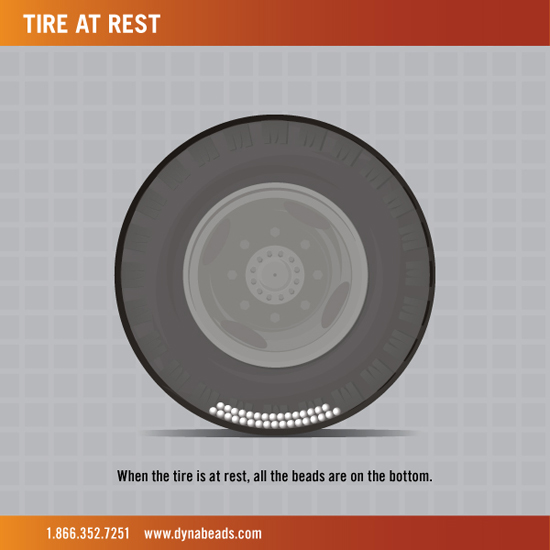
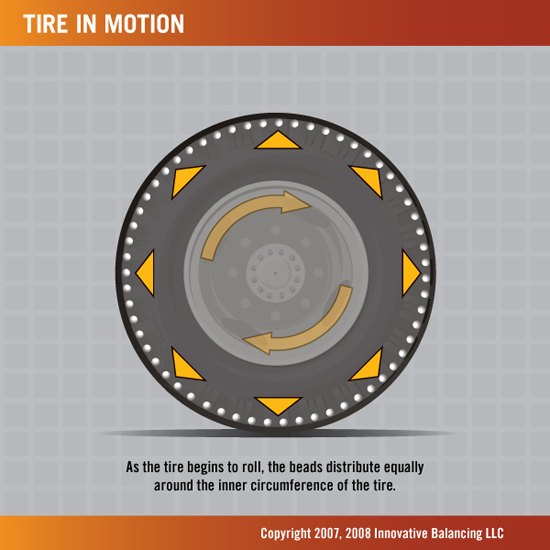
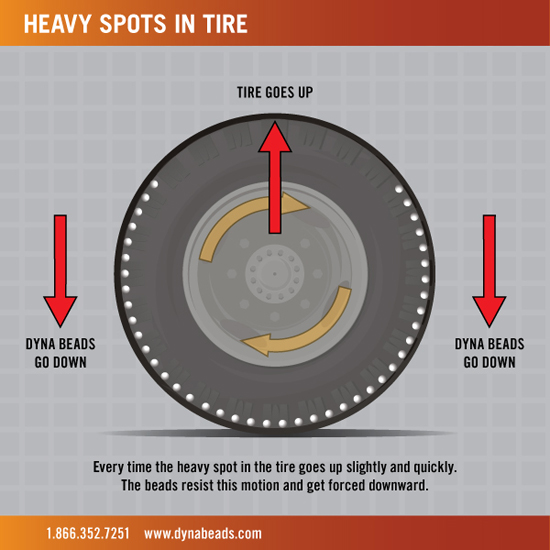
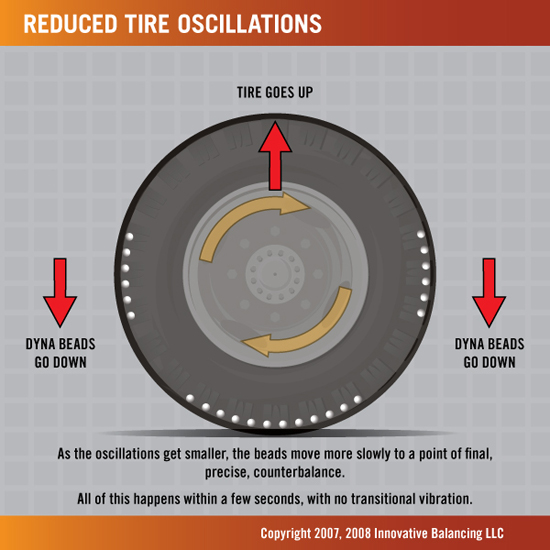
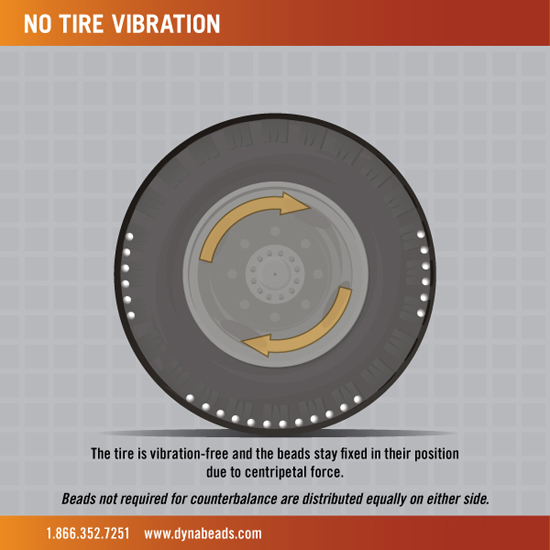
Also, Carol over at Innovative Balancing says that while the physics is sound, all circumstances are different and every set of tires can have their own issues.
We reached out to a long-time SEMI driver, who said:
They aren’t that common and there’s really nothing that says they’re effective. I’ve heard of them a lot more in offroad vehicles than in semi-trucks. Usually where the tire and rim are so large that clamping on weights is not really feasible (tire overruns the rim or rim has bead locks). I don’t think they work to balance the tire so much as they do to counter the vibration by absorbing some of it with kinetic energy.
Jason weighed in with:
- I don’t think the beads have much of a counter-balancing effect. I can’t image that the distribution of beads on the inside surface of the tire is all that dynamic. Once you get spinning, the beads are going to line up as we would expect them to, basically evenly spaced around the inside of the tire.
- Because the beads add substantial mass at the furthest point from the center of the wheel/tire assembly, they significantly increase the force of momentum in the direction of travel. This makes any small imbalance in the tire much harder to feel.
- Because all of these beads are equally distant from the center of the wheel/tire and because they’re evenly distributed along the inside of the tire, they help “move” the center of mass to where it should be.
So basically, they work, but not because of the reasons given on the InnovativeBalancing.com website. They just add weight to the tire tread in a very even manner.
If there’s a downside to these beads, it’s that they increase the rotational mass of each wheel by a large margin. That is going to reduce acceleration and hurt fuel economy…so I wouldn’t use these unless I absolutely had to.
Lastly, remember that Eric Johnson uses them and says they work well.
What do you think? Do you think they would work or is it just hogwash?
Related Posts:
2013 Toyota Tundra Project XU – Featured Truck
Truck Beadlock Wheels – What They Are and Why You Probably Don’t Want Them
Search terms people used to find this page:
- tire balancing beads
- https://tundraheadquarters com/bead-balancing-tires/
- tire balancing beads reviews
- tire beads
- bead bag balancing
- do tire balancing beads work
Filed Under: Tundra Wheels and Tires


These add a new meaning to the term “snake oil”.
What he said ^^
A tire on the road acts differently than the impressive but misleading example video above. There’s actually a lot more going on, but this’ll do for illustrative purposes:
Pick a spot of tire tread to follow, and if you actually study the motion, that spot is stationary (not moving at all) while in contact with the road surface, but because the vehicle is moving, it gets picked up and accelerates in a curved trajectory until at the top of that arc it is moving in the same direction as the vehicle but at twice the speed of the vehicle. Then it curves back down, decelerating all the while, to the road surface where it is again stationary for a split-second until it goes around again.
I’ll stick with wheel weights.
Steve
I bet tire shops will love them. Can you imagine what happens when you bust a tire off the rim. It will be like the ping pong balls on Cpt. Kangaroo for those of you who are old enough to remember.
On the bright side, maybe those little beads can seal a nail hole.
But mix in a bit of that green tire flat fix goop and it’s a big mess for the tire repair shop.
Steve
People will buy anything and I need to start selling stuff to them!
Not interested in beads. What about TPMS? Constantly hitting the sensor will make it go out.
Mickey,
Interesting thought on TPMS. I would assume it isn’t a problem since the featured Tundra owner didn’t say anything negative about them. I don’t know.
-Tim
If it gets rid of TPMS then that’s a good thing.
I have 2 cars and 1 truck I 2 sets of mounted tires for each. snow/summer. That 24 TPMS transmitters. No way I am paying for the second set for 3 cars/truck. All my vehicles have tape over the TPMS light. On one I took the dash apart and disabled the light.
Talk about a waste of money.
As for the beads, I think lead shot might work better.
Larry,
I’ve often wondering why you just don’t go to a junk yard and build your own truck! 🙂
-Tim
In did that once back in high school. I got a 1940 Ford truck for 150 bucks which was in a yard, got it running. Drove it 1 year and sold it for 250. All total I only lost about 300 dollars. No automatic widows on that one, no TPMS, not even an automatic choke, manual choke and throttle knobs. Vacuum wipers which stopped when you stepped on the gas. The front grill was missing, it took me 6 months to find one, that was the big expense on the project. Wish I still had it.
Those were the days when trucks were trucks and they were fun to work on and drive.
The RAM diesel I got last fall got smashed by a falling tree a few weeks ago. 8000 in damage. Just go the 7000 dollars check from the insurance company. It crushed the bed completely. I’m putting a steel flat bed on it for 3000 and investing the rest. Such a deal, even I get lucky sometimes. No TPMS on that truck either and no beads in the tires.
Keep up the good work Tim!
Good story Larry and thanks, I do the best I can.
-Tim
With these “bags of beads”, is that all you need?
I mean there are ZERO wheel weights then correct?
I am curious to how well it works on a jeep. Ive read articles on people using them on 18 wheelers and stuff. Hmmm..?
I always had a shimmy at 45 mph when I used beads. Went back to dynamic balance and all is good.